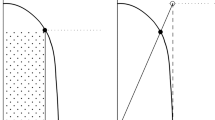Abstract
We consider the notion of Pareto optimality under the assumption that only the pairwise majority relation is known and show that the set of necessarily Pareto optimal alternatives coincides with the McKelvey uncovered set. As a consequence, the McKelvey uncovered set constitutes the coarsest Pareto optimal majoritarian social choice function. Moreover, every majority relation is induced by a preference profile in which the uncovered alternatives precisely coincide with the Pareto optimal ones. We furthermore discuss the structure of the McKelvey covering relation and the McKelvey uncovered set.



Similar content being viewed by others
Notes
Antisymmetry is not required for any of our results to hold. In fact, Theorem 1 is even stronger when also assuming antisymmetric individual preferences (since this only increases the difficulty of constructing a suitable preference profile).
Some authors call this strong Pareto optimality. In contrast, an alternative x would be weakly Pareto optimal if there is no alternative y with \(y\mathrel {P_i}x\) for all \(i\in N_{R}\). In the case of antisymmetric preferences, the two notions coincide.
Consider, for instance, the simple case of \(A=\{a,b,c\}\) and \(Q=\{(a,b),(a,c)\}\), which is easily seen not to be the covering relation for any preference profile.
The whole example was obtained from and proved minimal by an automated computer search based on the method developed by Brandt et al. (2014).
In fact, any tournament of size 7 can be realized by 3 agents.
This even holds when individual preferences are allowed to be weak orders.
The same counterexample also applies to the case of weak individual orders (i.e., without the assumption of antisymmetry of \(R_i\)). In this case there are 256 instead of 22 candidates for individual preferences relations, and additional constraints for the Pareto edges are required, which makes the resulting IP significantly larger, but still solvable within less than one second.
References
Bordes G (1983) On the possibility of reasonable consistent majoritarian choice: Some positive results. J Econ Theory 31(1):122–132
Brandt F, Fischer F (2008) Computing the minimal covering set. Math Soc Sci 56(2):254–268
Brandt F, Geist C (2014) Finding strategyproof social choice functions via SAT solving. In: Proceedings of the 13th international conference on autonomous agents and multi-agent systems (AAMAS), pp 1193–1200. IFAAMAS
Brandt F, Geist C, Seedig GH (2014) Identifying \(k\)-majority digraphs via SAT solving. In: Proceedings of the 1st AAMAS workshop on exploring beyond the worst case in computational social choice (EXPLORE)
Duggan J (2013) Uncovered sets. Soc Choice Welf 41(3):489–535
Dushnik B, Miller EW (1941) Partially ordered sets. Am J Math 63(3):600–610
Dutta B, Laslier J-F (1999) Comparison functions and choice correspondences. Soc Choice Welf 16(4):513–532
Gaertner W (2009) A primer in social choice theory: revised edition. In: LSE perspectives in economic analysis. Oxford University Press, Oxford
Gebser M, Kaminski R, Kaufmann B, Ostrowski M, Schaub T, Schneider M (2011) Potassco: the Potsdam answer set solving collection. AI Commun 24(2):107–124
Gebser M, Kaminski R, Kaufmann B, Schaub T (2012) Answer set solving in practice. Synth Lect Artif Intell Mach Learn 6(3):1–238
McGarvey DC (1953) A theorem on the construction of voting paradoxes. Econometrica 21(4):608–610
McKelvey RD (1986) Covering, dominance, and institution-free properties of social choice. Am J Polit Sci 30(2):283–314
Moulin H (1986) Choosing from a tournament. Soc Choice Welf 3(4):271–291
Peris JE, Subiza B (1999) Condorcet choice correspondences for weak tournaments. Soc Choice Welf 16(2):217–231
Schrijver A (1986) Theory of linear and integer programming. Wiley, New York
Author information
Authors and Affiliations
Corresponding author
Additional information
This material is based on work supported by Deutsche Forschungsgemeinschaft under Grants BR 2312/7-2 and BR 2312/9-1. Paul Harrenstein is supported by the ERC under Advanced Grant 291528 (“RACE”). The paper has benefitted from discussions at the 12th Meeting of the Society for Social Choice and Welfare in Boston (June 2014) as well as the Dagstuhl Seminar on Computational Social Choice (June 2015). The authors furthermore thank Jean-François Laslier and Hans Georg Seedig for helpful discussions and technical support.
Rights and permissions
About this article
Cite this article
Brandt, F., Geist, C. & Harrenstein, P. A note on the McKelvey uncovered set and Pareto optimality. Soc Choice Welf 46, 81–91 (2016). https://doi.org/10.1007/s00355-015-0904-5
Received:
Accepted:
Published:
Issue Date:
DOI: https://doi.org/10.1007/s00355-015-0904-5




